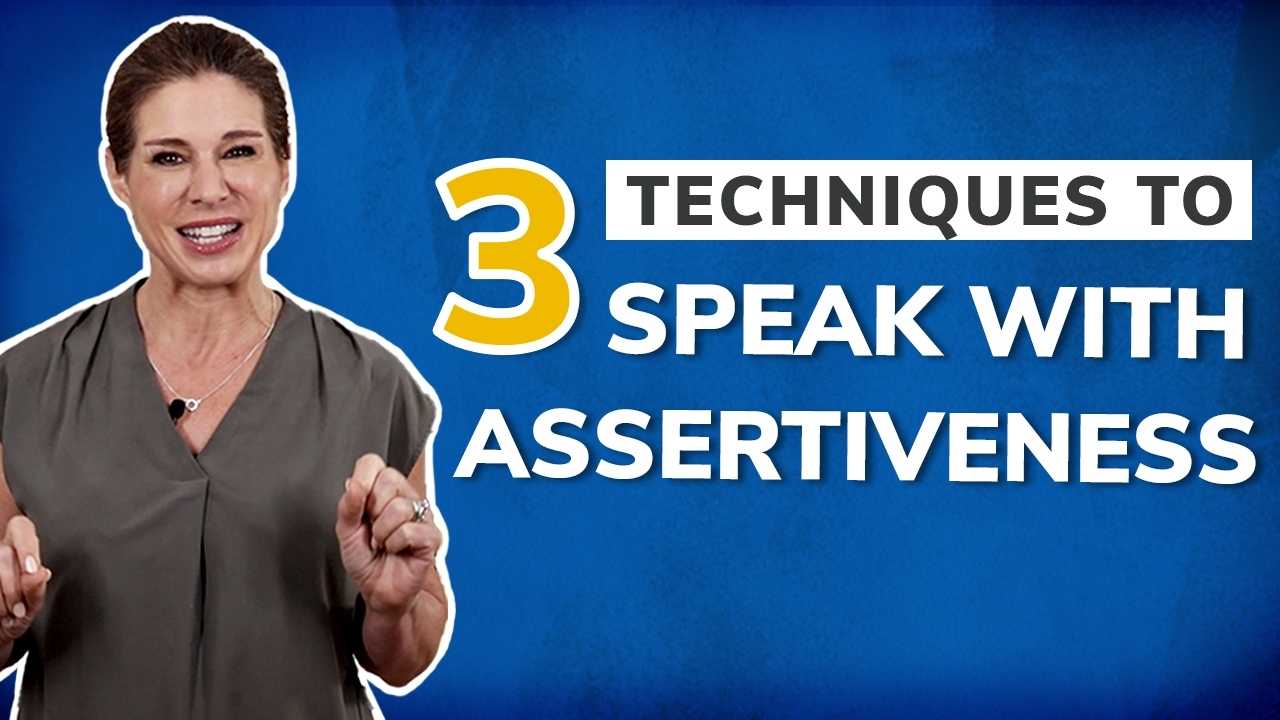Hi everyone, I’m Fia Fasbinder. Welcome to the Moxie Talk blog where we help you find your voice, share your message, and lead with confidence.
Now before we go into some techniques for assertive communication, if you are watching us on Youtube, make sure to press that alert button and subscribe to our channel so you get notified of all the great content we’re putting out there.
—
Welcome to another blog in our series of blogs on assertive communication.
As I’ve stated before, assertive communication is conveyed through your messaging but it is also conveyed through your verbal and non-verbal communication techniques.
Considering the work I do as an executive speaker coach to some of the world’s most confident and assertive communicators, I want to spend some time in this blog on my 3 go-to delivery pointers on how to use your voice and your body for assertiveness.
Before we dive into the actual tips let’s begin with a concept that I call
The Happy Warrior
The happy warrior is this concept that great leaders convey a combination of strength and warmth.
Lead with warmth, Follow with strength
They lead with warmth and follow with strength. Why? Because people need to trust their leader before they follow them. This applies so well to assertive communication.
If you think about how we are delivering the message, if we use the happy warrior approach of demonstrating both strength and warmth without showing aggression or even passiveness on the other side, we’ll bring the listener’s guard down or the person we’re delivering the message to and they will hear us.
Aggression will cause the person to go into defense mode while passiveness, on the other hand, will make them feel ignored or maybe seem to be meek.
Therefore, if we show too much strength upfront, our messenger will shut off. But if we show too much warmth upfront, we run the risk of not being taken seriously.
You can see how this balance of strength and warmth is not only different for all of us but will take some practice to get it right. Get it right in a way that feels genuine and authentic to you.
I’ll give you an idea of how this breaks down and how this can work for you. Eye contact and a smile demonstrate warmth in our body language while a firm handshake and confident, open body language demonstrate strength.
So you see how using all of these techniques in combination would lend assertiveness to the message we’re delivering to our listener.
—
Table of Contents
ToggleAssertive Communication Requires Vocal Executive Presence
With that in mind let’s begin with some vocal exercises that you can use to make sure that you are delivering your message with assertiveness.
When I speak about using your voice with assertiveness, I like to use the term vocal executive presence. We’ve all heard of executive presence and people that have executive presence have mastered the art of assertive communication.
Vocal executive presence is the way your voice either amplifies or undermines your message of executive presence and assertiveness.
I’ll give you some examples. Imagine two speakers with the exact same script:
- One speaker mumbles, speaks slowly, and doesn’t have any vocal variety.
- Another speaker speaks with projection, with warmth in their voice, they pause, and they emphasize at all the right places.
Which speaker are you going to listen to? Of course! The second, right? That’s because their voice is demonstrating vocal executive presence.
There are 3 go-to techniques that I use to make sure that speakers are conveying vocal executive presence with their voices.
Typically I use these techniques when I see some vocal traits that are undermining their message of executive presence. For example,
Speaking too softly
can undermine your executive presence.
Speaking too quickly
can undermine your executive presence.
Speaking in a high register
Speaking in a high pitch or a high register, which happens to a lot of women when we get nervous, undermines our executive presence.
A quivering voice
definitely undermines our executive presence.
I know if you recognize one of these vocal traits it is incredibly frustrating and it feels somewhat powerless to change. But there are techniques that you can use to change all of these so that your voice matches your message of assertiveness.
So let’s unpack my top 3.
—
Technique 1: Watch Your Tone Of Voice
First, watch your tone of voice. The self-control and the gravitas that I mentioned in my previous blogs is absolutely necessary here. Your voice needs to be relaxed and calm, yet also convey strength and groundedness.
This can take some time just like any new skill, so be patient with yourself and don’t get annoyed if you end up raising your voice without even realizing it or coming off as too harsh because you’re irritated. Keep practicing. Try again. Eventually this will be part of the way you communicate.
Assertive behavior also means not showing hesitation or even questioning through your voice. This will cause your listener to question your authority and even possibly discredit your assertive message.
Here’s a tone exercise that demonstrates the difference that tone can make. I’m often told by clients that they have one tone of voice Then when I introduced this exercise, it really showed how many different tones of voice they have.
I want you to imagine that you are saying ‘I have something to say!’ in a flat tone. You’ll notice there its said with almost no tone of voice ‘I have something to say.‘
Now I want you to imagine that you are saying this as if you are delivering good news. You can decide who the messenger and who the receiver of this message is. It could be your team, it could be a client, it could be a family member, and you are delivering good news and all you can say is ‘I have something to say.’ Go ahead and say it out loud now.
Again, imagine on the flip side of that you are delivering bad news to that client or that team or those family members and again, you can only say ‘I have something to say,’ and say it out loud. Think about how different you sounded when you are delivering bad news than good news.
Then the third tone is to imagine that same team or those same family members or that same client and they are not listening to you. They are too busy talking, they’re distracted and you say, ‘I have something to say,’ this time to get their attention. Go ahead and say it out loud. You will notice again how different you sound there.
Understand that tone can make a huge difference in the way we deliver our message, but we have to make sure that our tone matches the message. Hence, if our message is one of assertiveness, or if our message is one of showing strength and warmth, we need to make sure our tone matches this.
Your tone must match your message
One easy way to do this is to think of a person in your life that you use that assertive yet non-aggressive tone with—for me it’s my kids.
There are many times when I have to tell my kids a rule that they don’t agree with and I need to say it in a way that’s not going to put them on defense. I need to not raise my voice, yet let them know that I am strong and that they are not going to push me over and yet still be loving and caring.
Thus, it could be your kids, maybe your pets when you’re training your pets, whoever this person is in your life, and practice. Practice imagining that person and practice the tone that you need to have assertive communication.
—
Technique 2: Supportive Breathwork
My second go-to vocal tip for assertive communication is to breathe. Diaphragmatic breathing, or what we call breath support, adds power to your voice by making it deeper for both men and women and more rich and resonant and louder, but it won’t sound harsh or like you’re screaming.
In fact, breath support is the only way to add volume to your voice. That means if you come off as too quiet or when you get nervous or you get soft, this is the technique for you.
Coming off as too quiet when you’re delivering your message of assertiveness could be seen as meek which will not help you demonstrate your executive presence. Additionally, if your voice tends to go into a high pitch or a head register when you’re nervous, which happens to a lot of women, then this is a key technique for you to learn.
Let me unpack and explain breath support to you.
Oftentimes when I am explaining breath support I use a sushi visualization. Now if you can imagine sushi, or nigiri more specifically, it is fish with rice underneath.
Now imagine that that fish is your voice and the rice is your breath and you are supporting your voice with breath. This is breath support and this is exactly what we’re doing when we want to have powerful, resonant voices.
There is a rather simple technique that you can use to make sure that you are accomplishing this and it is called
diaphragmatic breathing
Your diaphragm is a sheath of muscle that sits between your chest and your abdomen and its whole purpose in your body is to push extra air into your lungs.
For most of us, our diaphragms lay dormant because we don’t need it in our day-to-day communication. When we get nervous, not only does our diaphragm lay dormant, but it tightens up because all of our muscles in our body are constricting and when your diaphragm tightens up you cannot get enough breath out to have a powerful voice.
So what we really need to do is relax our diaphragm and use it to support our breath so we push all that extra air into our lungs and out our mouths so that we have deep, rich, resonant voices.
In order to do this, I’m going to ask you to put your hand on your belly, or where you feel your breath rising and falling, or your belly pushing out and pushing in.
You can do this now at home, where nobody can see you or in your office. Feel that rising and falling sensation. Welcome to your diaphragm.
Now I want you to imagine that inside your diaphragm, or inside your belly, you have this giant red balloon.
Notice every time you breathe in, that balloon fills up with air and your belly pushes out. What’s more, every time you breathe out, all that air comes out of your diaphragm. Your belly goes towards your belly button, all that air comes out of your mouth, and your balloon deflates.
This is diaphragmatic breathing. We also call this
horizontal breathing
Because we’re breathing in and out, not up and down. So why is this so important?
Your diaphragm sits right below the lungs and heart and just above your belly, so if you’re scrunching or you’re hunched over, you can’t get enough length in your diaphragm to really harness all of that air.
Likewise, if you’ve ever seen a picture of your lungs, you notice that you have two sets of lungs: you have your upper lungs and your lower lungs.
Your lower lungs are actually the biggest, most oxygen-rich part of your lungs. Therefore when you incorporate your diaphragm, you push it out, all that air goes into those bottom lungs it comes out your top lungs and it comes out your mouth.
This is why this is horizontal breathing, also called belly breathing, also called diaphragmatic breathing. Actually, I do not care what you call it, but here’s how you’re gonna do it:
Put your hands on your belly, breathe in feel that balloon fill up with air, and then on your exhale I want you to say ‘Hey’. Notice when you say ‘Hey‘ all that air comes out your mouth and your hand goes in towards your belly button.
If this is still really difficult for you, I highly recommend you lay down on your back. I know how ridiculous this sounds but, when you do that, you will naturally fall into diaphragmatic breathing.
What is more, if you want extra brownie points, put a heavy book or a computer on your belly (not your desktop) your laptop, and breathe in and feel your computer or your book push out. Then breathe out and feel it going in. You will really make sure that you’re doing this technique correctly.
Once you have mastered just breathing in and out using your diaphragm, it’s time to make sure that we say this on words. You’re going to breathe in and I want you to say ‘Hey you,’ and really imagine that assertive voice that is bouncing off the wall in front of you or the window in front of you and coming right back to you.
Now I want you to say (make sure you hear yourself breathe in before) ‘Hey you over there!’ and notice that you spoke on the exhale. We always speak on the exhale.
Then you’re going to breathe in and you’re going to say ‘Hey you over there, get off of my cloud!’ and you might find by cloud, you are out of breath and this is absolutely okay.
I know how ridiculous this seems, but there is absolutely 100% no other way to get a powerful, rich, resonant voice that doesn’t shake, doesn’t quiver, doesn’t run out of breath than doing breath support exercises. It is literally the only way. So if you can keep your WHY in mind, hopefully, it will push you through some uncomfortable exercises.
If you are running out of breath, coming off too quiet, or going into your head register, breath support will fix all of these vocal problems. All you have to do is breathe in, on your exhale breathe out, and say your words, and Practice! Practice! Practice!
I guarantee that this will make sure that you eliminate all of these vocal habits that are undermining your assertiveness.
—
Technique 3: The Ghost Exercise
My third go-to tip for assertive communication is for all of you whose voice quivers when you’re nervous and you have something important or difficult to say.
This, I know, is the most powerless nervous feeling because you don’t know if it’s going to happen, when it’s going to happen, how badly it’s going to happen, if it’s going to stop, and there’s nothing worse than needing to communicate assertively like asking for a raise or telling somebody that you can’t do something and your voice starts to quiver.
This technique will literally stop that quivering in its tracks and it builds on the diaphragmatic breathing exercise that I taught you previously. Again, it’s just as silly, but this works.
Why does your voice quiver?
It quivers because your vocal cords, which are also known as vocal folds, their whole purpose in your body is to stop you from drowning, to stop water from going into your lungs.
Obviously, this is a really important purpose but your vocal folds don’t know the difference between stress because you’re drowning and stress because you’re asking your boss for a raise. They just know stress.
For this reason, anytime they feel under duress, they shut. When they shut, you can’t use all that beautiful breath support that you just learned and the little air that’s there causes your voice to quiver.
How do we get around this?
Here’s how we do it. There is a technique that we can use to tell our vocal cords that everything’s cool, they can relax, they are just fine, and this is how it works—
You are going to put your index finger two inches away from your mouth (this is not the silly part), the silly part is now you are going to think of the sound you made as a kid when you are pretending to be a ghost. It probably sounded like “Wuuuuuuuuuuu.”
You’re going to do that sound but while you’re doing it, you are going to pay attention to your breath support. Meaning you are going to breathe in, fill up that balloon in your belly, and on your exhale you are going to make that ghost sound.
The reason your finger is about two inches away from your mouth so that you should feel all that beautiful air coming out and on your finger. You can feel it, right?
Let’s try it now:
It should goes like this: breathe in… breathe out—“Wuuuuuuuuuuu.” You’re going to do that 5 to 10 times, hopefully not in front of your boss. This will absolutely relax your vocal cords so that it doesn’t quiver.
Nevertheless, if you hear your voice quivering the first couple of times you do this, keep going. Again, this is an exercise which you might have to only do it 5 times or you might have to do it 10 times or you might have to do it 20 times, until those dang vocal cords RELAX.
I know this is silly, but it really works. If you came backstage at any TED event that I was coaching for, you would see my speakers doing all sorts of silly things with their voices from ghost exercises to scales to breathing exercises to speaking to walls saying ‘Hey you over there get off of my cloud,’ which, by the way, is a rolling stone song that I never told you before.
This concludes the end of our blog on how to use your voice to make sure you are amplifying your message of assertive communication. Hopefully you found this valuable. If you did, please subscribe to our Youtube channel. Please like it, share it with anyone you think would also find it valuable.
Until next time, don’t forget to live brilliantly, lead boldly, and Speak with Moxie.











